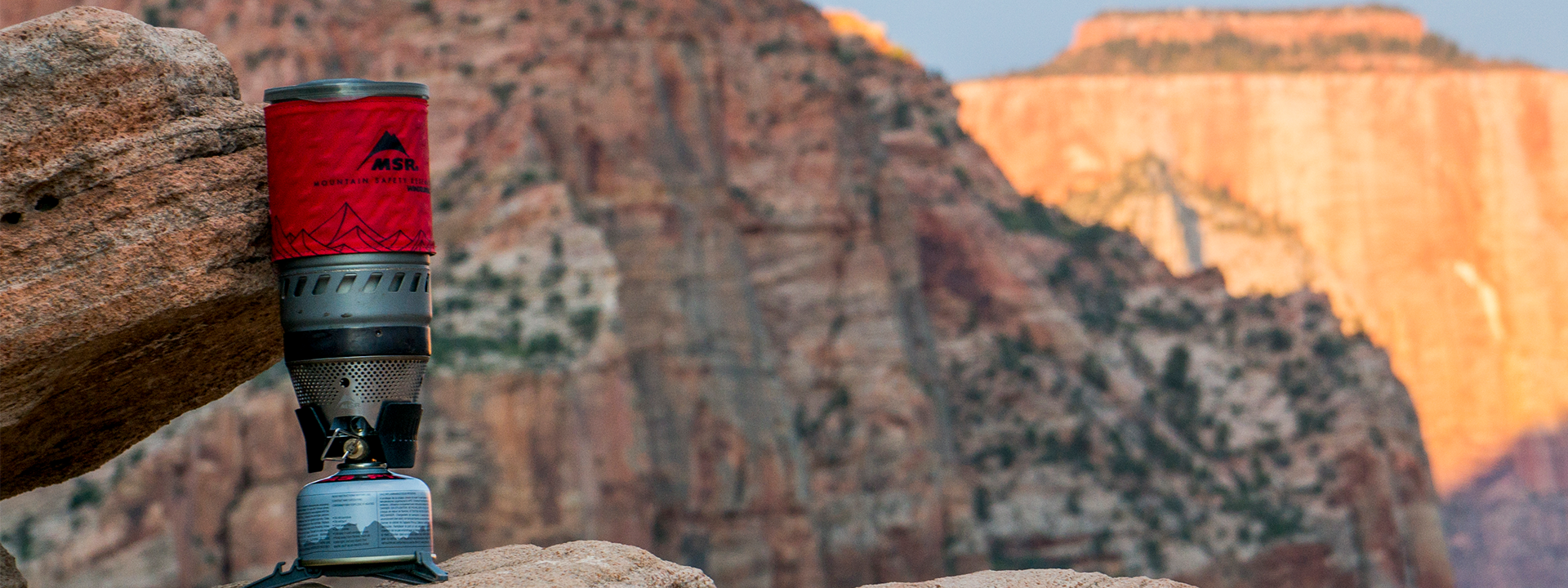ProView – MSR Windburner Stove
The camp stoves of my youth were inefficient, clunky things that always seemed equally likely to explode as to make breakfast. Stoves like the MSR Whisperlite improved our options, but for most of my formative years planning food for fast and light adventures still meant candy bars and cold instant coffee. Fortunately, the JetBoil revolution brought us into a new age of enlightenment, where light packs and hot food are no longer mutually exclusive. MSR has upped the game again with the Windburner cooking system.
If you’re looking for an integrated cooking system like this one, you’re probably torn between the tried and true JetBoil and the slightly more expensive MSR Windburner. Let’s look at what sets them apart.
When I came home to find the stove-shaped box waiting on the doorstep I tore into it enthusiastically. I discarded the box and the paperwork to behold what was, at first glance, a JetBoil. But red. Ok, cool. A red JetBoil. It wasn’t until I spent some time with the Windburner (and friends with JetBoils) that MSR’s attention to detail really came to light.
Design and Construction
There are three really evident differences between the JetBoil and the Windburner. For starters, MSR opted for a significantly more dispersed flame profile than JetBoil. JetBoil’s heating source really looks like it’s coming out of the back of an F-16, and spreads heat through a wavy metal heating element. The MSR stove applies heat with a flame that is spread across the entire base of the integrated pot, which has a built in heat exchange unit that is claimed to increase efficiency and decrease susceptibility to the elements.
The Windburner also sports a ported windscreen around the flame surface, while the JetBoil doesn’t offer any substantive wind protection.
The third big difference, and the one that you’ll notice right away, is that the Windburner doesn’t include a sparker to ignite the stove. I’ve heard plenty of reports of JetBoil clickers wearing out, but I wish that MSR had included one or at least an intuitive way to bring one along. A lighter doesn’t fit inside the cooking pot with the stove and a fuel canister, and the additional requirement takes away from the elegance of the design.
The practical differences come with construction designs that are less obvious. JetBoil uses a high density foam sheath for insulating the pot, and a nylon webbing strap for handling hot liquids. MSR’s stove uses a denser, solid insulation that is remarkably efficient. I have no issues picking up the pot while it’s at a rolling boil. MSR’s handle is stiff and effective, but ultimately unnecessary given the efficacy of the Windburner’s insulating sheath.
Generally speaking, the Windburner just feels like it’s higher quality than the JetBoil. Manufacturing tolerances feel tighter. Small details haven’t been overlooked. It’s a thoughtfully constructed stove.
For the gram counters out there, the Windburner is slightly bigger, and slightly heavier.
Performance
The Windburner hangs its hat on two main claims. First, that it’s fuel efficient, and second, that it’s effective in stormy conditions.
As far as fuel efficiency goes, I’m skeptical that there’s a huge difference. JetBoil claims that a 100g canister will boil 12 liters of water, which is spot on for what I’ve seen with the Windburner. If you’re efficient with your cooking (and you’re a coffee drinker), you should be able to get by for a week on a single canister.
I did, however, notice a real difference in windy and stormy conditions. The Windburner is great, if you can get it lit. Once both stoves were lit, the Windburner outlasted the JetBoil in every test of wind and moisture. However, I’ve had a real problem with getting the stove lit in the wind with a regular Bic lighter. If you plan on making dinner or tea on many exposed ridgelines, I recommend packing a more robust, torch style lighter.
Conclusions
The Windburner outperformed the JetBoil in pretty much every test. At the end of the day, my take is that the Windburner is a dramatically more versatile, better built stove than the JetBoil. But at nearly twice the price, it’s up to you to decide where your priorities lie.
What I loved about the MSR Windburner Stove:
- Performs well in windy conditions (if you can get it lit)
- Excellent manufacturing quality
- Efficient insulation and heating
Areas for improvement:
- Expensive
- Difficult to light in windy conditions
- Marginally heavier than JetBoil
Shop MSR on Outdoor Prolink.
Not an Outdoor Prolink member yet? Apply now!
Ben Horan is a freelance writer and guide based in Missoula, Montana, and blogs at thegentlemanatlarge.com (Instagram: @thegentlemanatlarge).






